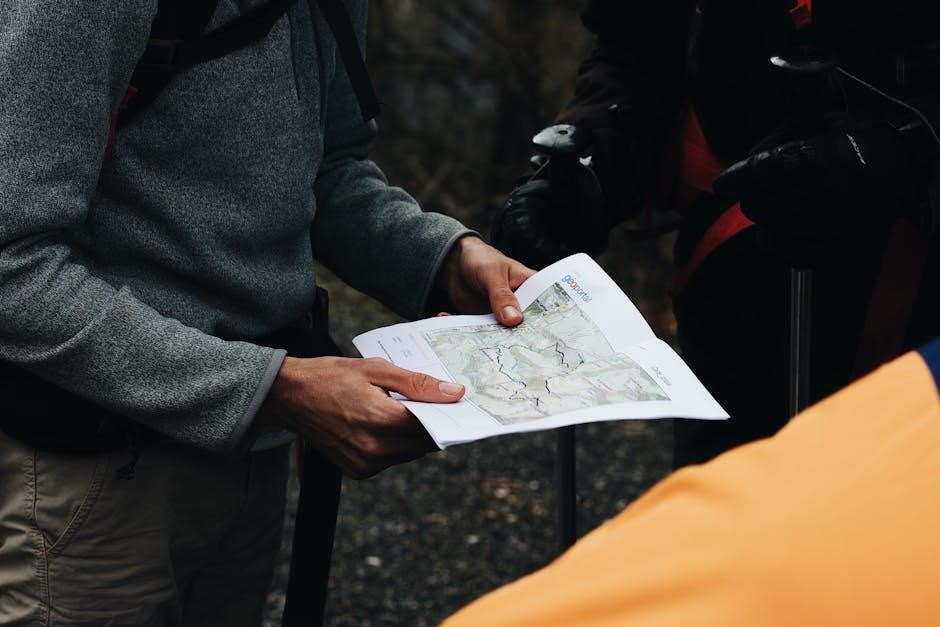The trigger point chart pdf is a professional tool designed to assist practitioners in identifying and managing myofascial trigger points with a structured format and visual maps online.
Definition and Purpose
The trigger point chart pdf is defined as a visual tool used to identify and document myofascial trigger points, which are areas of hyperirritable muscle tissue that can cause pain and discomfort. The purpose of this chart is to provide a structured format for practitioners to assess and manage trigger points, ultimately improving patient care and outcomes. By using a trigger point chart pdf, practitioners can streamline their assessments and develop effective treatment plans. This chart is an essential resource for healthcare professionals, including physical therapists, massage therapists, and chiropractors, who work with patients experiencing myofascial pain syndrome. The chart’s purpose is to facilitate accurate identification and treatment of trigger points, leading to improved patient outcomes and enhanced quality of life. Overall, the trigger point chart pdf is a valuable tool in the management of myofascial trigger points.
Importance of Trigger Point Chart
The trigger point chart pdf holds significant importance in the field of myofascial pain management, as it enables practitioners to accurately identify and document trigger points. This chart is crucial in developing effective treatment plans, which can lead to improved patient outcomes and enhanced quality of life. By utilizing a trigger point chart pdf, practitioners can better understand the complex relationships between trigger points, pain patterns, and muscle function. The chart’s importance extends to its ability to facilitate communication between healthcare professionals, ensuring that patients receive comprehensive and coordinated care. Furthermore, the trigger point chart pdf serves as a valuable educational tool, helping to raise awareness about myofascial pain syndrome and the importance of proper trigger point management. Overall, the trigger point chart pdf is a vital resource in the diagnosis and treatment of myofascial trigger points, and its importance cannot be overstated.

Benefits of Using Trigger Point Charts
Using trigger point charts offers numerous advantages for practitioners and patients with accurate diagnoses and treatments always available online easily.
Visual Precision
The trigger point chart pdf provides a clear visual representation of trigger point locations within muscles, aiding practitioners and individuals in accurate identification and diagnosis of myofascial pain syndrome.
This visual precision enables targeted treatment and management of trigger points, reducing muscle pain and discomfort.
The chart’s visual maps illustrate hypersensitive trigger points, making it easier for practitioners to understand and address trigger points within muscles.
With this visual aid, individuals can better understand their condition and work with practitioners to develop effective treatment plans.
The trigger point chart pdf is a valuable resource for anyone seeking to manage myofascial pain syndrome and improve overall muscle health.
The chart’s visual precision is a key benefit, making it an essential tool for practitioners and individuals alike.
It is a useful tool for understanding and managing myofascial trigger points.
The visual representation is easy to understand and use.
Targeted Diagnosis and Treatment
The trigger point chart pdf enables targeted diagnosis and treatment of myofascial pain syndrome by providing a clear understanding of trigger point locations and pain patterns.
This allows practitioners to develop effective treatment plans tailored to individual needs.
The chart helps identify specific muscles and trigger points involved in pain patterns, enabling precise treatment and management.
Practitioners can use the chart to educate patients about their condition and involve them in the treatment process.
The chart’s targeted approach to diagnosis and treatment can lead to improved outcomes and reduced muscle pain and discomfort.
By using the trigger point chart pdf, practitioners can provide personalized care and attention to each patient’s specific needs.
This targeted approach is essential for effective management of myofascial pain syndrome.
The chart is a valuable resource for practitioners seeking to provide high-quality care.
How to Use Trigger Point Chart
Using the chart involves downloading and printing the template to identify trigger points accurately online always.
Step 1: Download the Printable Template
To begin using the trigger point chart pdf, the first step is to download the printable template, which can be found online through various resources. This template is designed to provide a structured format for identifying and documenting myofascial trigger points. By downloading the template, practitioners and individuals can access a comprehensive tool to aid in the assessment and management of trigger points. The template is typically available in a PDF format, making it easy to print and use. Once downloaded, the template can be printed and used to record trigger point locations, pain patterns, and other relevant information. This step is crucial in utilizing the trigger point chart pdf effectively, as it provides a foundation for accurate identification and treatment of myofascial trigger points. The downloadable template is a valuable resource for both healthcare professionals and individuals seeking to manage trigger point pain.
Understanding the Chart
The trigger point chart pdf is a visual map that illustrates hypersensitive trigger points within muscles, providing a clear representation of pain patterns and locations. To understand the chart,! it’s essential to familiarize oneself with the anatomy and physiology of the muscles and their corresponding trigger points. The chart typically includes illustrations of the muscles, trigger point locations, and pain referral patterns, making it a valuable tool for accurate identification and treatment. By studying the chart, practitioners and individuals can gain a deeper understanding of the complex relationships between muscles, trigger points, and pain patterns. This knowledge enables effective assessment and management of myofascial trigger points, leading to improved patient care and outcomes. The chart’s visual representation facilitates comprehension, making it an indispensable resource for healthcare professionals and individuals seeking to manage trigger point pain and discomfort.
Types of Trigger Point Charts
Various trigger point charts exist, including wall charts and online resources, providing different formats and information.
Travell, Simons, and Simons Point Pain Patterns Wall Charts
Travell, Simons, and Simons point pain patterns wall charts are highly regarded in the field of myofascial pain and dysfunction. These charts provide detailed illustrations of trigger point locations and corresponding pain patterns. They are based on the work of Drs. Travell, Simons, and Simons, as presented in their seminal book, Myofascial Pain and Dysfunction: The Trigger Point Manual. The charts are designed to be a visual aid for healthcare professionals, helping them to accurately identify and treat myofascial trigger points. By using these charts, practitioners can improve their understanding of trigger point anatomy and develop effective treatment plans for their patients. The charts are a valuable resource for anyone working in the field of myofascial pain and dysfunction, and are widely used in clinical and educational settings. They offer a comprehensive and authoritative guide to trigger point identification and treatment.
Download and Access
Users can download the trigger point chart pdf from online resources and access it instantly with a single click and start using it immediately online.
Free Download Options
There are various websites that offer free download options for the trigger point chart pdf, allowing users to access and print the chart without any cost or subscription.
These websites provide a convenient way to obtain the chart, and some of them also offer additional resources and information on trigger points and myofascial pain syndrome.
The free download options are available in different formats, including PDF, which can be easily printed and used as a reference guide.
Users can search for these websites online and download the trigger point chart pdf for free, making it a widely accessible resource for both healthcare professionals and individuals.
The availability of free download options has made it possible for people to learn about trigger points and manage myofascial pain syndrome more effectively.
Overall, the free download options for the trigger point chart pdf have increased accessibility and convenience for users.
Online Resources
There are numerous online resources available that provide access to the trigger point chart pdf, including websites and online libraries.
These resources offer a wide range of information on trigger points and myofascial pain syndrome, as well as downloadable charts and guides.
Some online resources also offer tutorials and videos on how to use the trigger point chart pdf effectively.
Additionally, online forums and discussion groups provide a platform for users to share their experiences and ask questions about trigger points and myofascial pain syndrome.
Overall, the online resources available for the trigger point chart pdf are extensive and provide a valuable source of information for both healthcare professionals and individuals.
The online resources are constantly updated with new information and research, making them a reliable and trustworthy source for learning about trigger points and managing myofascial pain syndrome.
The chart provides a clear and visual representation of trigger points and their corresponding locations.
By using the trigger point chart pdf, healthcare professionals and individuals can effectively identify and manage trigger points.
The chart is also a useful resource for educating patients about their condition and treatment options.
Overall, the trigger point chart pdf is an essential tool for anyone looking to manage myofascial pain syndrome and improve their overall health and wellbeing.
The chart is widely available online and can be easily downloaded and printed for use.
With its clear and concise information, the trigger point chart pdf is an invaluable resource for both healthcare professionals and individuals.
It provides a comprehensive understanding of trigger points and their management.



















